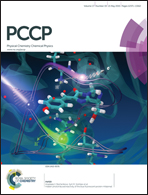Infrared spectra of small anionic water clusters from density functional theory and wavefunction theory calculations†
Abstract
We performed systematic theoretical studies on small anionic water/deuterated water clusters W/D−n=2–6 at both density functional theory (B3LYP) and wavefunction theory (MP2) levels. The focus of the study is to examine the convergence of calculated infrared (IR) spectra with respect to the increasing number of diffuse functions. It is found that at the MP2 level for larger clusters (n = 4–6), only one extra diffuse function is needed to obtain the converged relative IR intensities, while two or three more sets of extra diffuse functions are needed for smaller clusters. Such behaviour is strongly associated with the convergence of the electronic structure of corresponding clusters at the MP2 level. It is striking to observe that at the B3LYP level, the calculated relative IR intensities for all the clusters under investigations are diverse and show no trend of convergence upon increasing the number of diffuse functions. Moreover, the increasing contribution from the extra diffuse functions to the dynamic IR dipole moment indicates that the B3LYP electronic structure also fails to converge. These results manifest that MP2 is a preferential theoretical method, as compared to the widely used B3LYP, for the IR intensity of dipole bounded electron systems.


 Please wait while we load your content...
Please wait while we load your content...